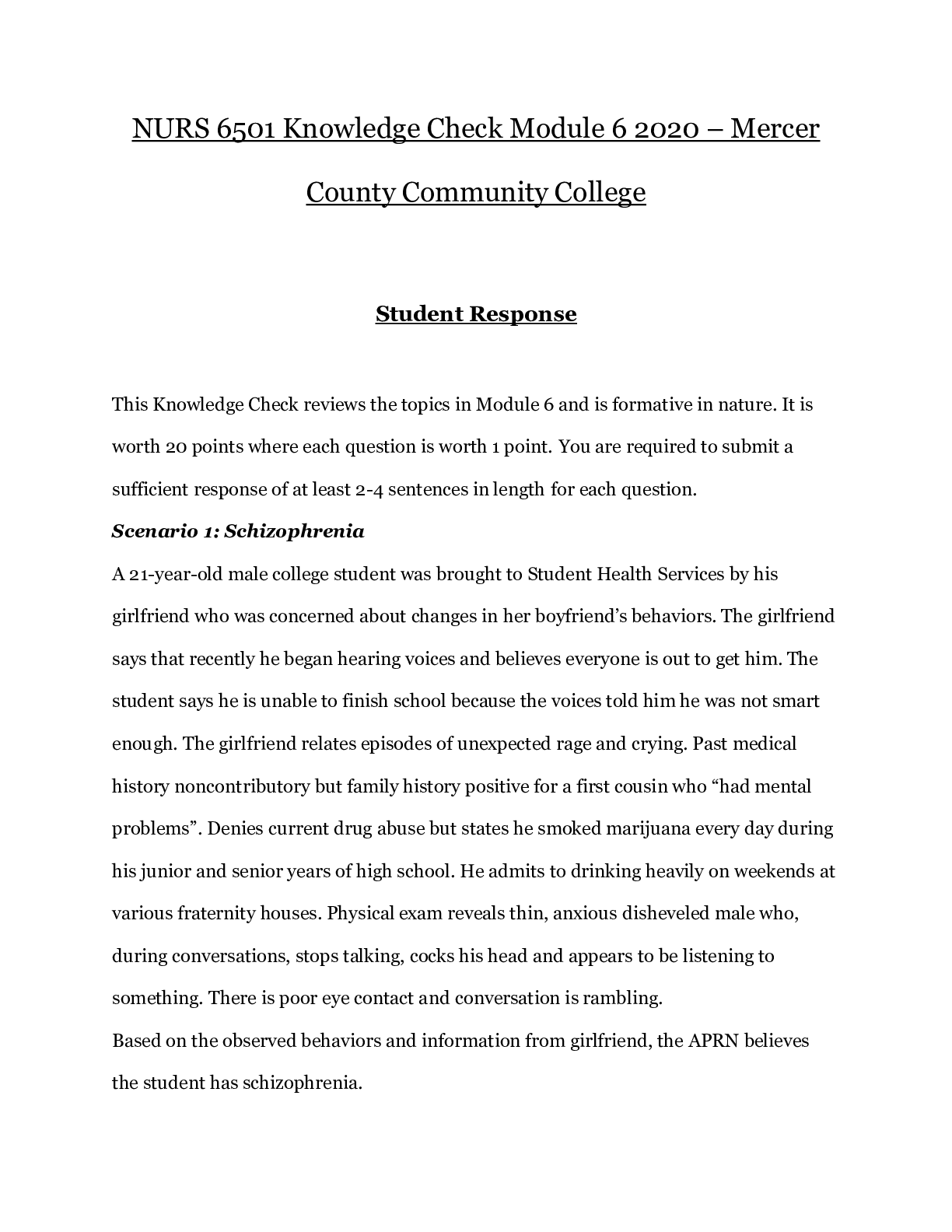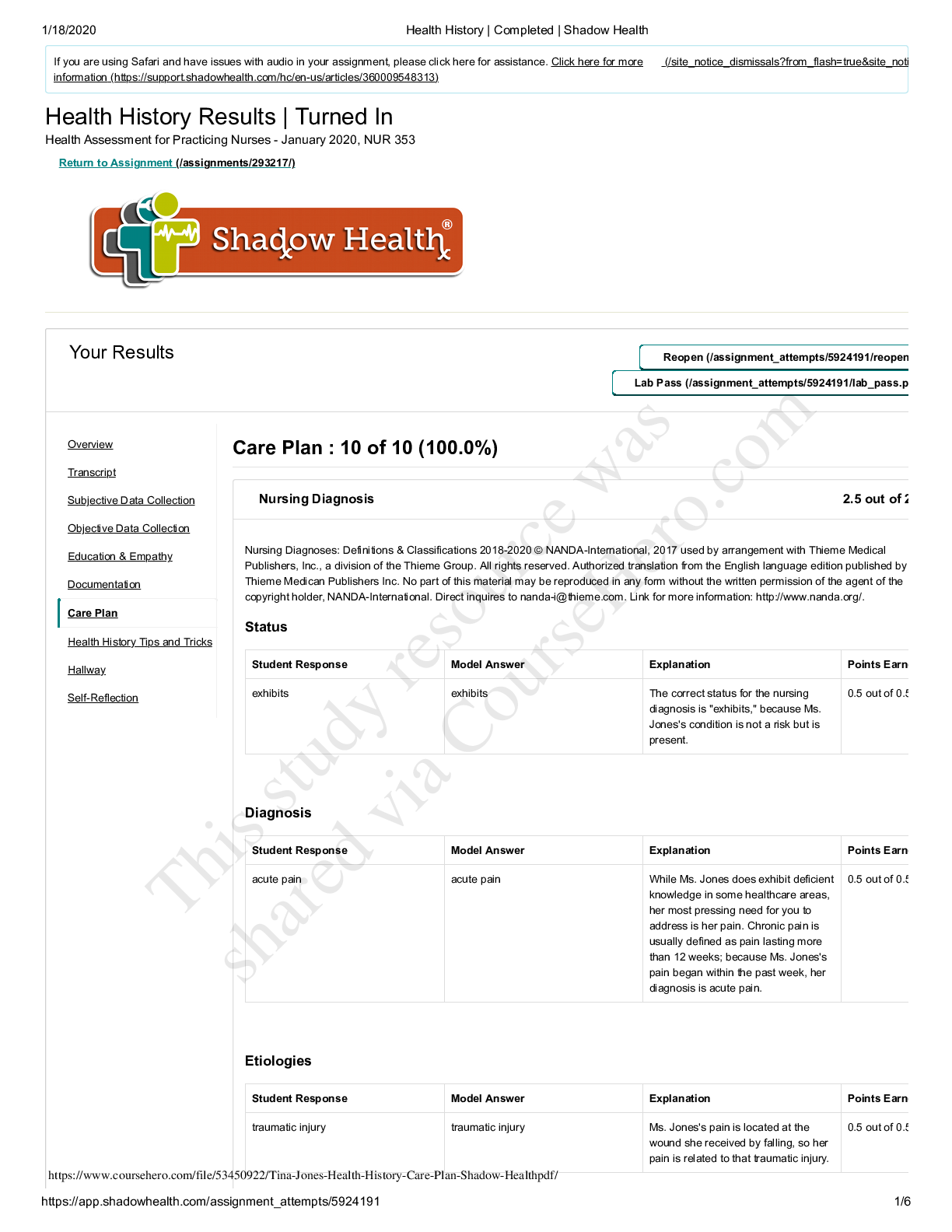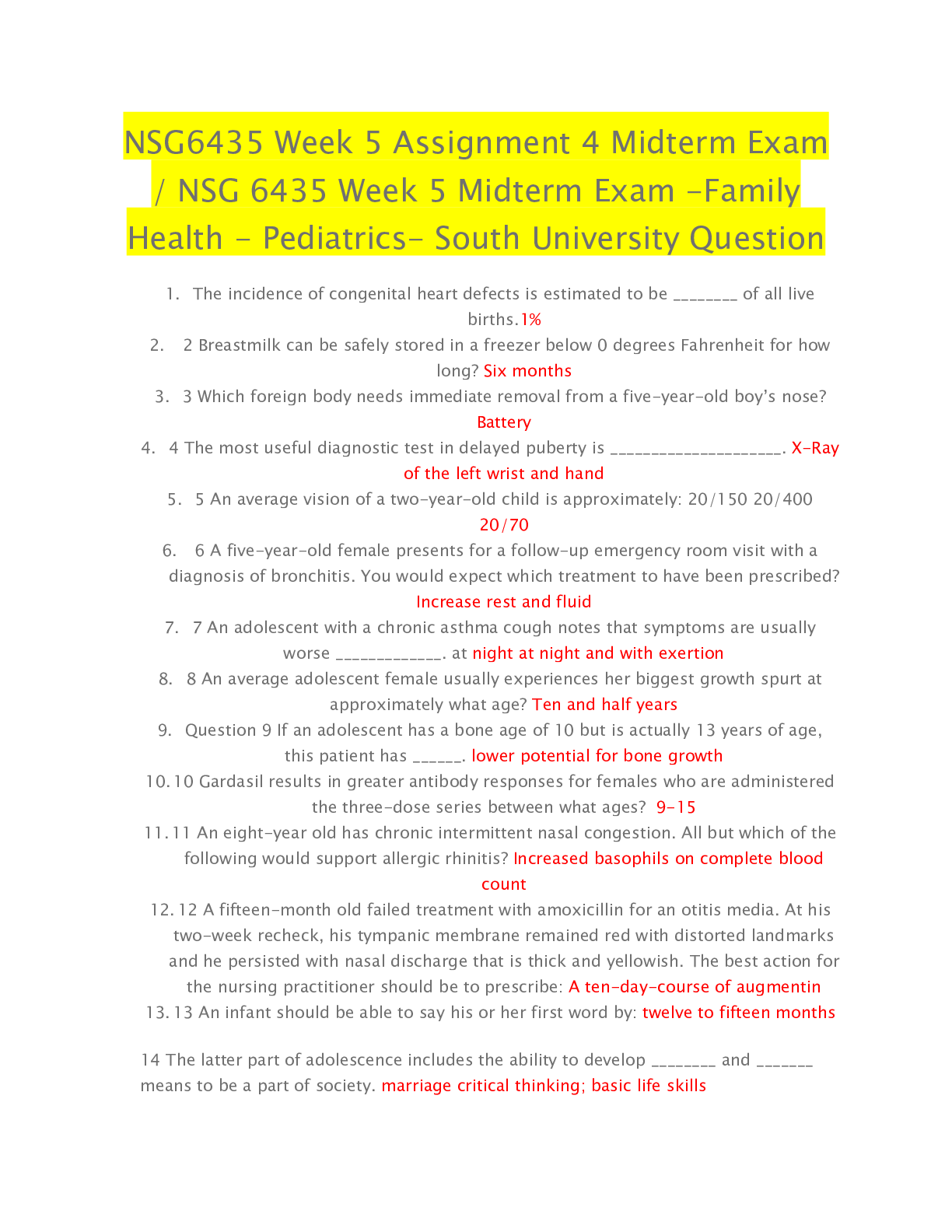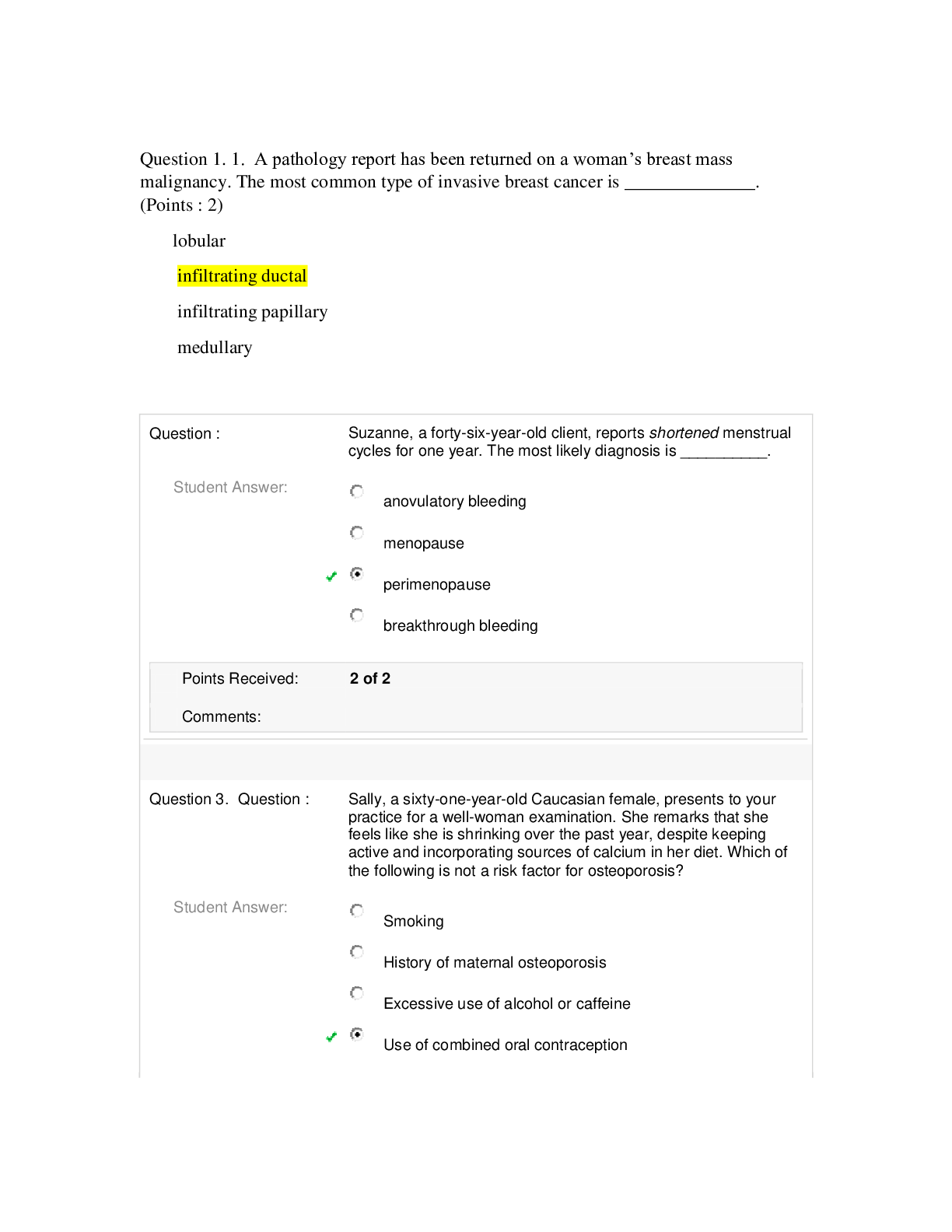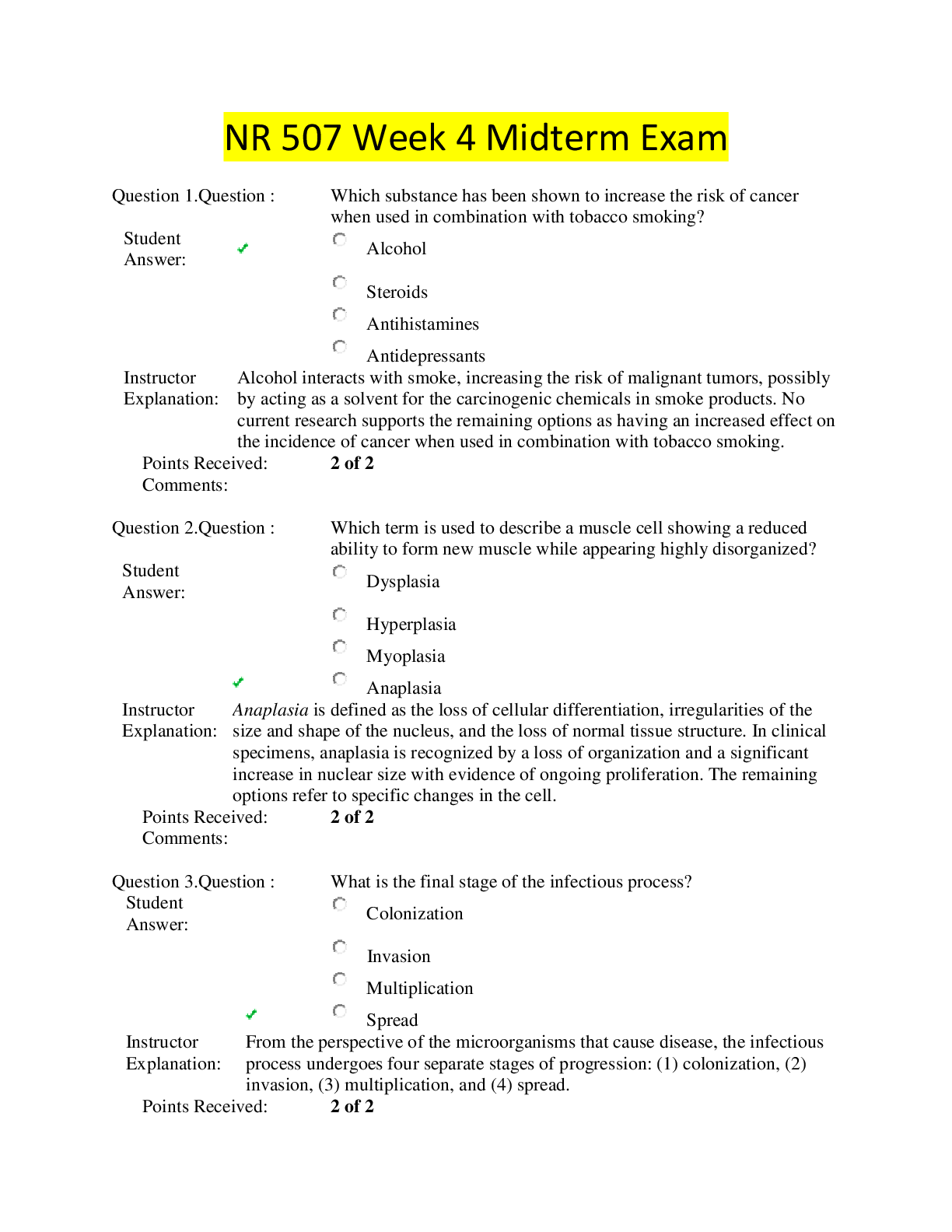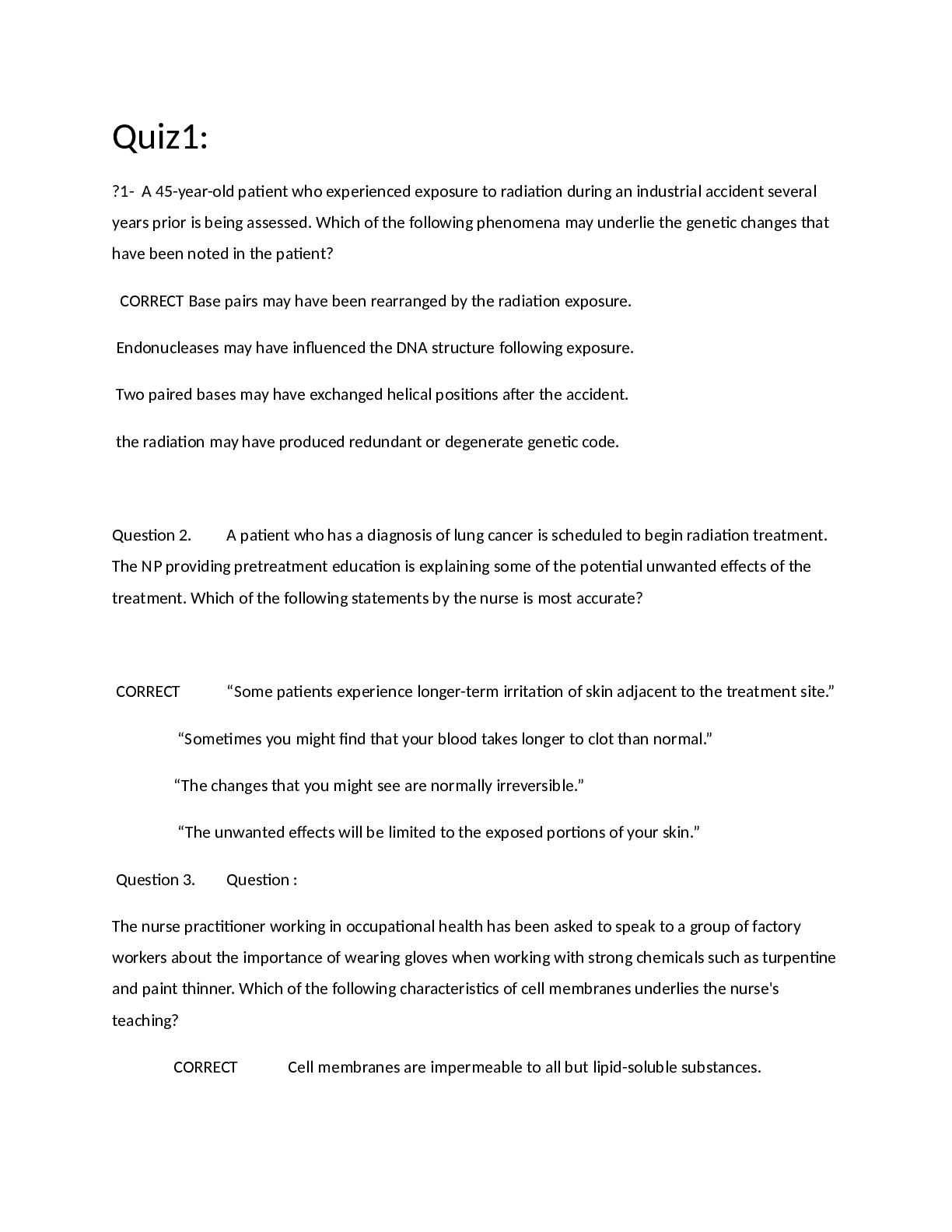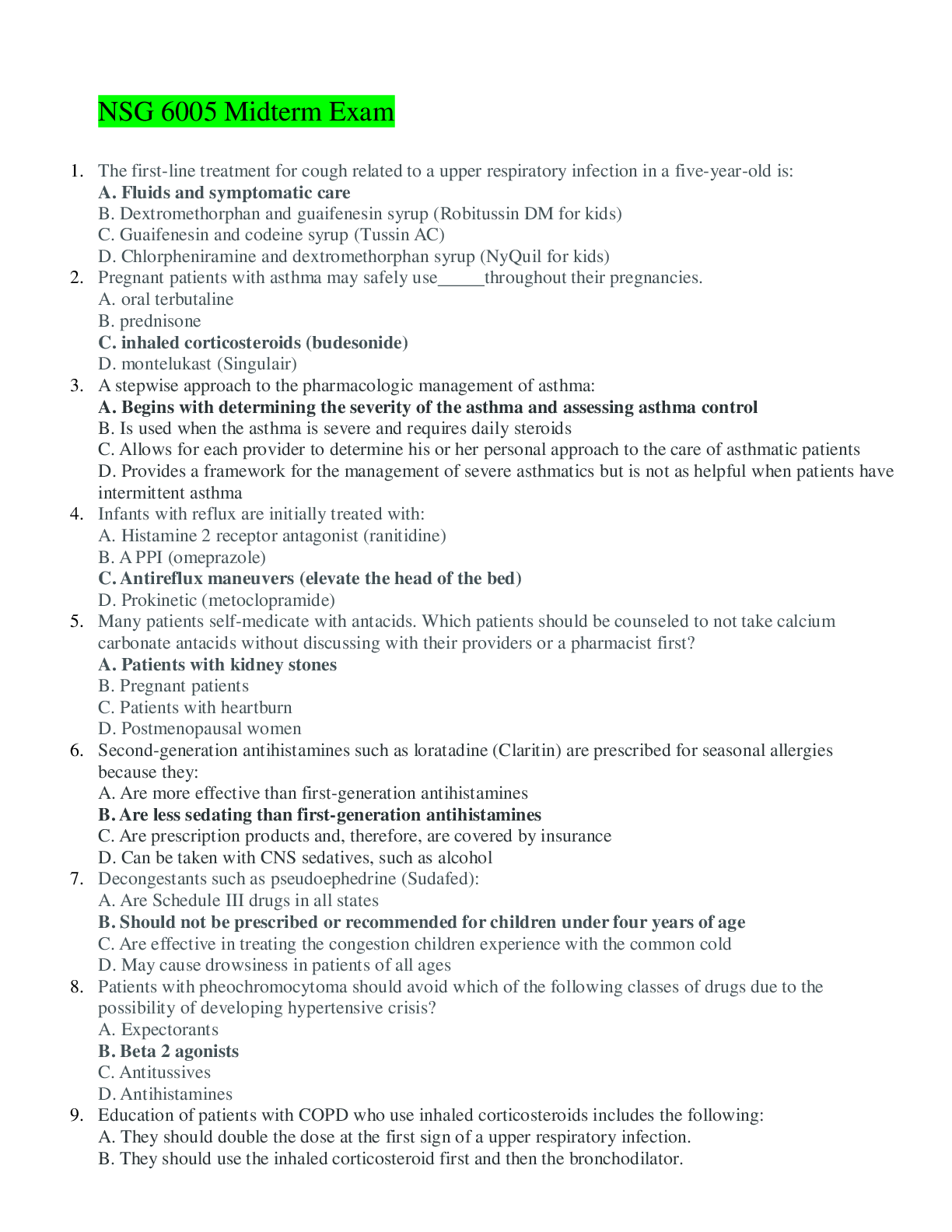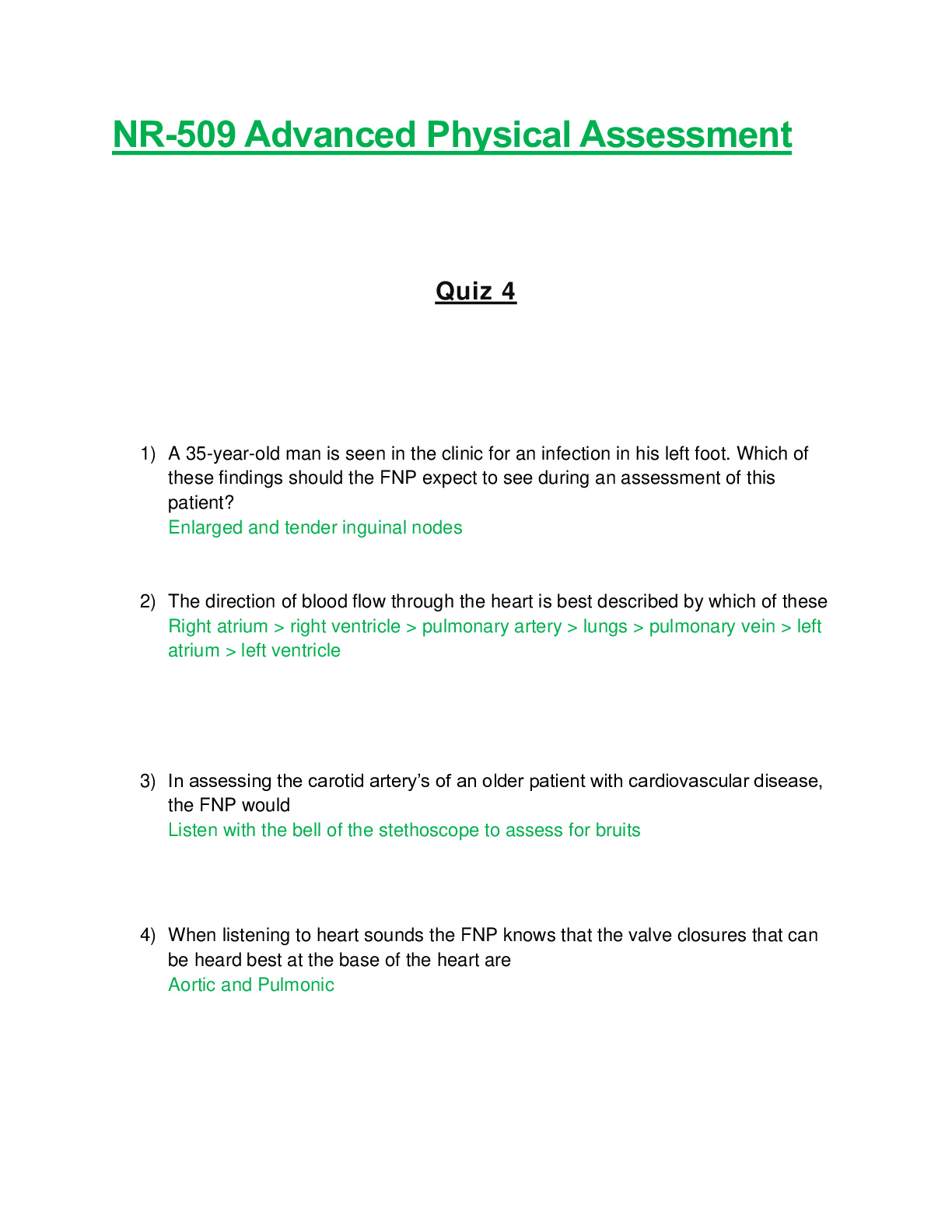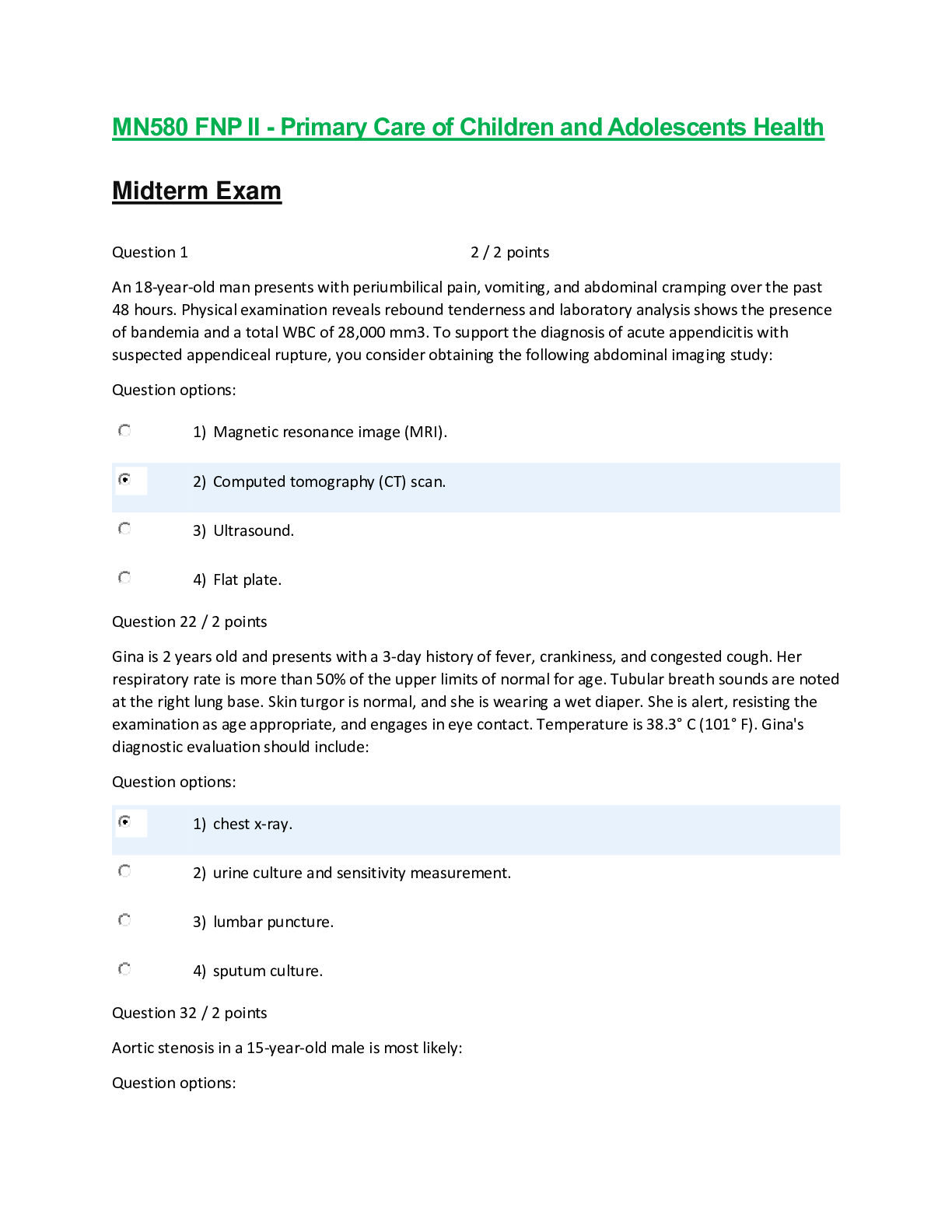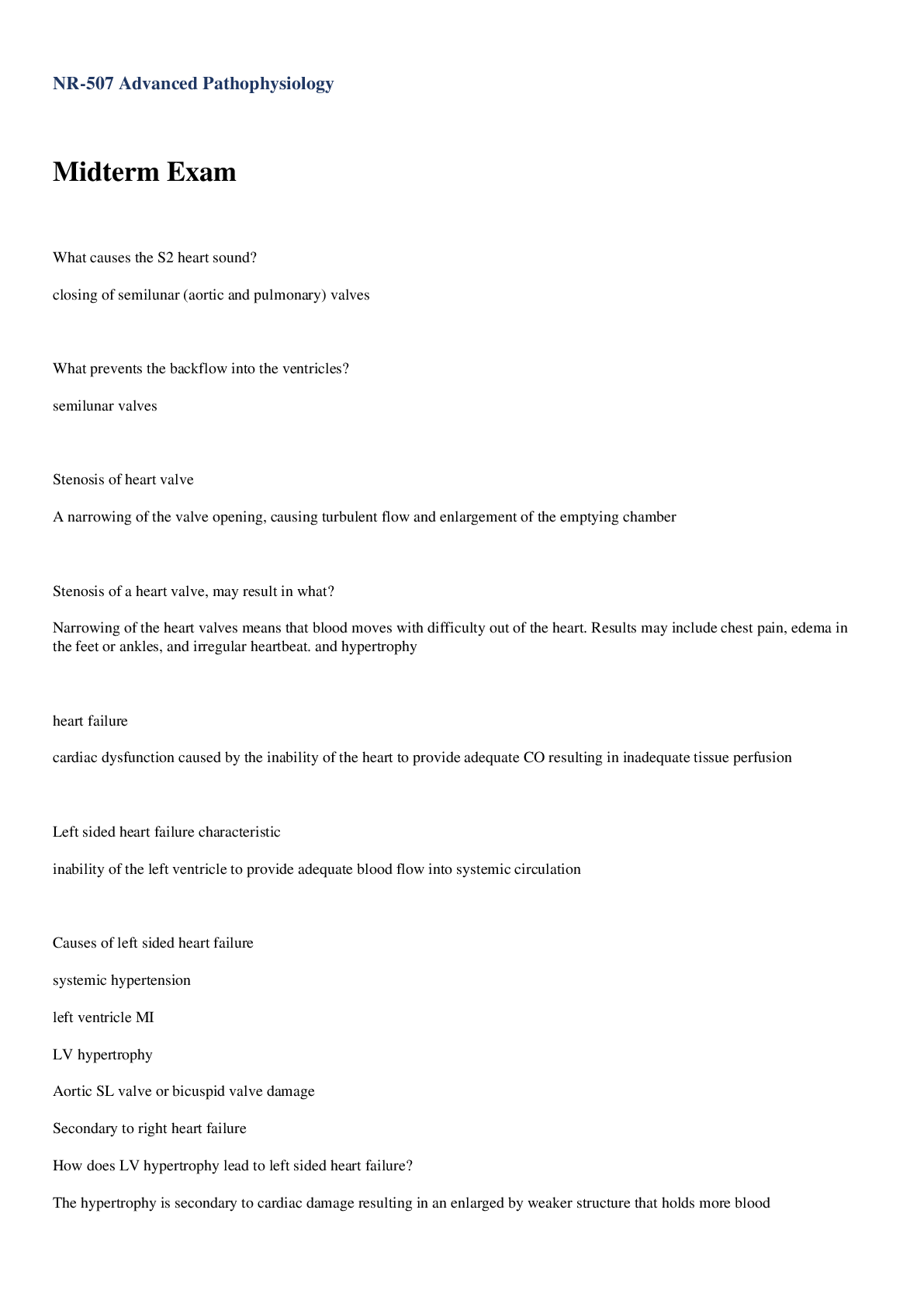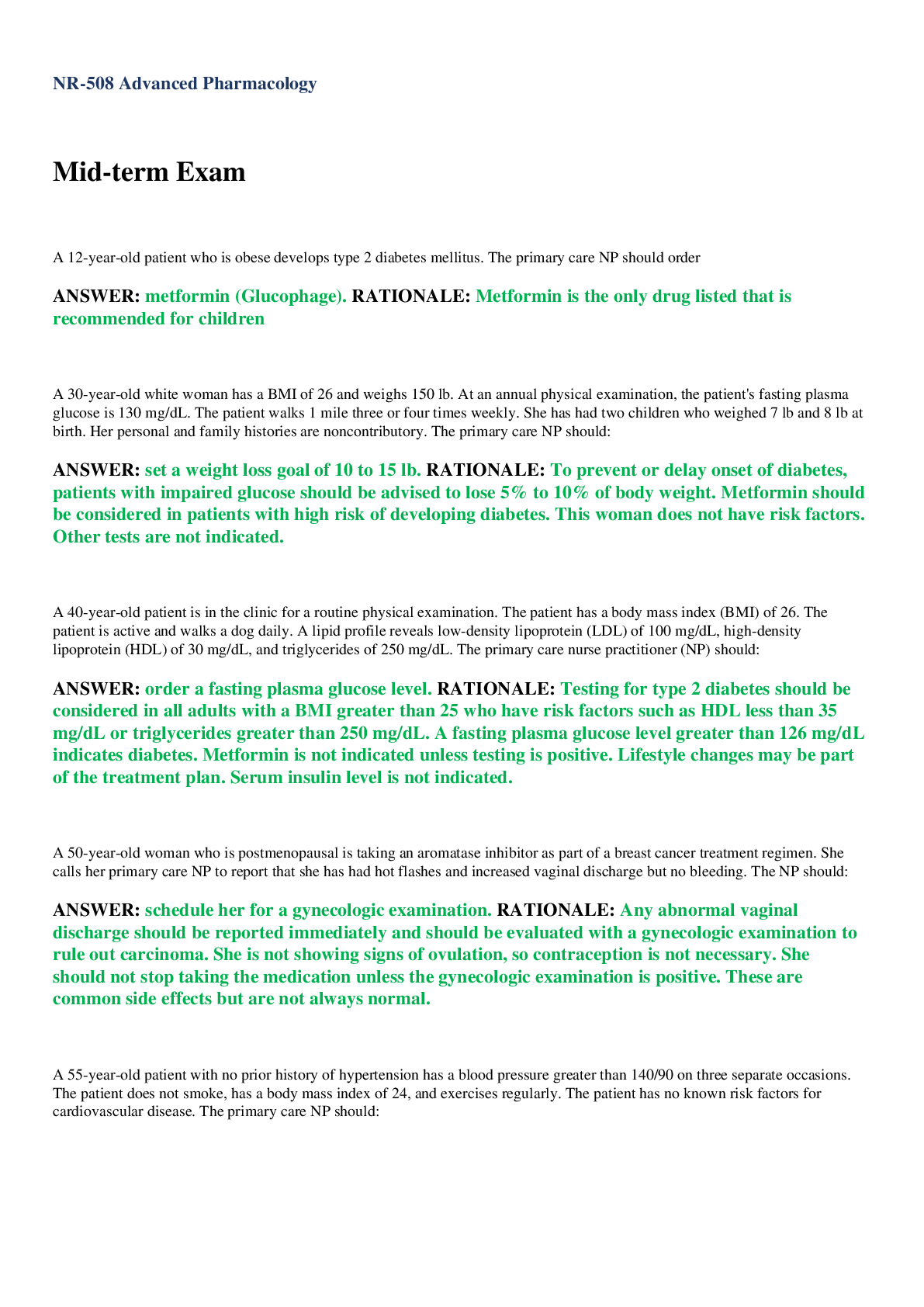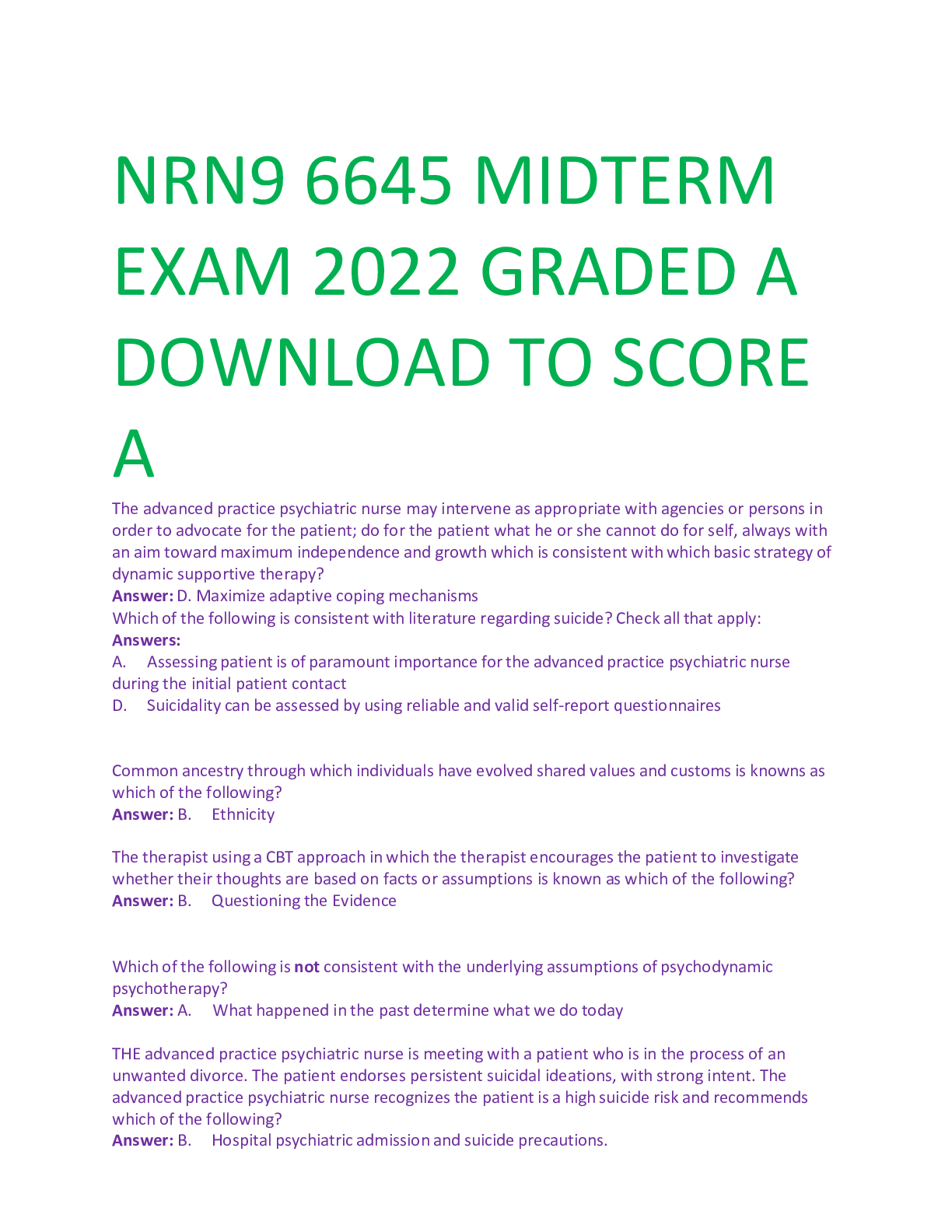*NURSING > EXAM > NSG6435 Week 5 Assignment 4 Midterm Exam / NSG 6435 Week 5 Midterm Exam -Family Health - Pediatrics- (All)
NSG6435 Week 5 Assignment 4 Midterm Exam / NSG 6435 Week 5 Midterm Exam -Family Health - Pediatrics- South University
Document Content and Description Below
NSG6435 Week 5 Assignment 4 Midterm Exam / NSG 6435 Week 5 Midterm Exam -Family Health - Pediatrics- South University 1. The incidence of congenital heart defects is estimated to be ________ of all l... ive births. 20% 10% 5% 1% 2. 2 Breastmilk can be safely stored in a freezer below 0 degrees Fahrenheit for how long? Three months Six months One year Two years 3. 3 Which foreign body needs immediate removal from a five-year-old boy’s nose? Bean Bead Stone Battery 4. 4 The most useful diagnostic test in delayed puberty is _____________________. complete thyroid panel X-Ray of the left wrist and hand X-Ray of the right wrist and hand X-Ray of the spinal column 5. 5 An average vision of a two-year-old child is approximately: 20/150 20/400 20/70 20/30 6. 6 A five-year-old female presents for a follow-up emergency room visit with a diagnosis of bronchitis. You would expect which treatment to have been prescribed? Oral steroids Azithromycin Increase rest and fluid Albuterol 7. 7 An adolescent with a chronic asthma cough notes that symptoms are usually worse _____________. only with exertion only during the daytime only at night at night and with exertion 8. 8 An average adolescent female usually experiences her biggest growth spurt at approximately what age? Ten and half years Eleven and half years Twelve and half years Thirteen and half years 9. 9 If an adolescent has a bone age of 10 but is actually 13 years of age, this patient has ______. an increased risk of fracture in the next three years an increased risk of osteoporosis as an adult a higher potential for bone growth a lower potential for bone growth 10. 10 Gardasil results in greater antibody responses for females who are administered the three-dose series between what ages? Six to twenty-six years of age, Prior to eleven years of age, Nine to fifteen years of age Nine to twenty-six years of age 11. 11 An eight-year old has chronic intermittent nasal congestion. All but which of the following would support allergic rhinitis? Red swollen turbinates Darkened areas below eyes Increased basophils on complete blood count (CB Itchy, watery eyes 12. 12 A fifteen-month old failed treatment with amoxicillin for an otitis media. At his two-week recheck, his tympanic membrane remained red with distorted landmarks and he persisted with nasal discharge that is thick and yellowish. The best action for the nursing practitioner should be to prescribe: A ten-day-course of augmentin A three-week-course of a cephalexin A higher dose amoxicillin Ceftriaxone and an antihistamine 13. 13 An infant should be able to say his or her first word by: four to five months eight to nine months twelve to fifteen months twenty four to twenty six months 14 The latter part of adolescence includes the ability to develop ________ and _______ means to be a part of society. strong attachments; sexuality career; marriage critical thinking; basic life skills moral; intellectual means 15 A fourteen-year-old adolescent presents with fatigue, endocarditis, pulmonary hypertension, arrhythmias, and congestive heart failure. You suspect he may have ____________. ASD pulmonary valve stenosis aortic valve stenosis a ventricular septal defect (VSD) 16 A four-year-old male patient presents with his mother with a school referral regarding red eyes. Which questions would not assist in establishing a list of differential diagnoses? Unilateral vs. bilateral presentation Type of drainage Vision status History of a bacterial infection one month ago 17 ______________ adolescents should be screened for sexually transmitted diseases. Males Females All Sexually active 18 An infant should no longer have a head lag when pulled from the supine to sitting position at what age? Two months Four months Six months Nine months 19 ____________ should be given as a supplement in the management of delayed puberty. Vitamins B1 and B12 Vitamins D and E Vitamin A and Calcium Calcium and Vitamin D 20 Parents or guardians of adolescents should ___________________. not be included in the adolescent's health care receive health guidance information at least twice during adolescence encourage reasonable use of alcohol and tobacco by the adolescent encourage early sexual activity by providing condoms to the adolescent 21 How does cultural sensitivity impact the care of infants in the primary care setting? Health-care providers may possess cultural biases that can impact care. Cultural sensitivities do not exist in health care. Cultural sensitivity only impacts the parents of infants. Cultural sensitivity increases access to timely health-care services for infants. 22 The most typical chest radiographic finding consistent with the diagnosis of asthma is ______________. normal chest film diffuse airway edema right upper-lobe infiltrate hyperinflation 23 A 10 yo has a single painful ulcerated lesion on an erythematous base on the inner buccal mucosa. The most likely diagnosis and treatment would be: herpes simplex stomatitis--oral acyclovir herpangina--viscous xylocaine apthous ulcer--triamcinalone in orabase Hand, foot, mouth syndrome--antibiotic mouthwash 24 A 9 month old is noted to have a bifid uvula. This would increase his risk of developing which disorder? otitis media retropharyngeal abscess sinusitis dental malocclusion 25 All of the following may predispose a patient to thrush except: age steroid therapy antibiotics poor oral hygiene 26 Patients with sinusitis should be instructed not to participate in what activity? swimming/ diving boxing/ wrestling weightlifting cross country running 27 What complication of sinusitis are adolescent males more prone to? intracranial abscess potts puffy tumor orbital cellulitis dental infection 28 Acceptable management options for allergic rhinitis include all of the following except: oral cetirizine oral montelukast nasal beclomethasone nasal neosynephrine 29 A 7 yo has experienced recurrent nose bleeds in the past 2 months. What finding on the physical exam would suggest an underlying medical cause for the epistaxis? wheezing grade II murmur petechiae tonsil hypertrophy 30 A 2 yo male with a history of chronic serous OM is noted to have a pearly white opacity in the upper outer quadrant of his TM. He currently has no symptoms and appears to be ok. The most likely diagnosis and appropriate management would be: tympanosclerosis; no treatment is necessary persistent perforation; prescribe topical antibiotic drops foreign body; perform an ear wash for removal cholesteatoma; refer to otolaryngology 31 A 15 mo failed treatment with amoxicillin for OM. At his 2 week re-check his TM remained red with distorted landmarks and he persisted with nasal congestion, poor sleep, and fever. The next best step would be to treat with: a 10 day course of augmentin a 3 week course of cephalosporin a higher dose of amoxicillin and topical abx ceftriaxone and an antihistamine 32 All but which one of the following patients are at an increased risk of developing otitis media? 2 yo with cleft palate repair at 1 year of age 15 mo with down syndrome 9 mo with lactose intolerance 3 yo with IgA immune deficiency 33 Patients with otitis externa should be instructed to do which one of the following: keep ear dry until symptoms improve limit swimming for the remainder of summer wear ear plugs at all times with swimming use alcohol drops before swimming each day 34 A 10 yo has marked ear pain, not wanting anyone to touch his ear. The canal is edematous and exudate is present. TM is normal. How should this be managed? topical fluoroquinolone oral steroids and topical neomycin oral amoxicillin and topical anesthetic oral amoxicillin and topical steroid 35 A 16 yo was hit in the eye 1 day ago and now has ecchymoses on the upper and lower lids with 5/10 eye pain. All but which of the following would be appropriate to obtain at this time: visual acuity intraocular pressure CT scan fluorescein stain 36 The greatest risk in a patient with a hyphema is which of the following? glaucoma infection rebleed cataracts 37 Corneal abrasions can be managed with topical application of which of the following: anesthetic for pain control steroids to prevent adhesions antibiotics to prevent infection atropine to prevent ciliary spasm 38 Trauma to the eye increases the risk of developing all but which one of the following? strabismus glaucoma cataracts hyphema 39 Fluorescein staining of the eye is used to detect a: keratitis foreign body corneal abrasion hyphema 40 Prematurity increases the risk of developing which one of the following? nystagmus astigmatism myopia glaucoma 41 A 3 month old has a mild asymmetrical corneal light reflex on physical exam. What is the next appropriate step? observe and reevaluate at the next well check refer immediately to ophthalmology begin atropine drops or eye patching protect eyes from sunlight 42 Which of the following may cause microcephaly? Hypocalcemia Craniosynostosis Skull fracture Seizure disorder 43 What finding may accompany macrocephaly? Pulsating anterior fontanel Sunken fontanel Premature closure of suture lines Widened suture lines 44 Obtaining a CT of the head would be indicated in which of these conditions? Macrocephaly Cephalohematoma Craniosynostosis Caput succedaneum 45 Which one of the following conditions increases the risk of developing hydrocephalus? Bilateral cephalohematomas Craniosynostosis Prematurity Familial macrocephaly 46 A conjunctivitis appearing in a 2-day old newborn is likely due to: chemical irritation from eye drops group B streptococcus chlamydia gonorrhea 47 Confirming the diagnosis of chlamydia conjunctivitis in a newborn would best be done by obtaining which one of the following? cervical swab of the mother urine PCR from the mother culture of the eye discharge culture of the conjunctival scrapings 48 Which one of the following eye findings would be considered an ophthalmic emergency? unilateral vesicular lesions on the upper eyelid of a 3 week old presence of chemosis in a 5 yo with bilateral upper eyelid edema cobblestone-like appearance along the inner aspect of the upper eyelid in a 15 yo bilateral redness along the eyelid margins with tiny ulcerated areas in a 16 yo 49 The most appropriate management of a 5 yo with a firm, nontender nodule in the mid-upper eyelid for 3 weeks would be: cool compresses topical ophthalmic ointment oral antibiotics oral steroids 50 Daily eyelid cleansing with diluted baby shampoo and a cotton tipped applicator would be appropriate in the treatment of which one of the following conditions? Dacryostenosis Chalzion Hordeolum Blepharitis 51 A 3-year-old has an edematous, mildly erythematous right upper eyelid for one day with a fever of 103. An important eye assessment would be ocular mobility conjunctival inflammation pupillary reaction optic disk papilledema 52 Concurrent otitis media and conjunctivitis is likely due to which organism? streptococcus pneumoniae Haemophilius influenza Moraxella catarrhalis staphylococcus aureus 53 A 16 yo girl makes the following statements to you during her health visit. Which of the following pieces of information should not be kept confidential? I have been sexually active with three of my boyfriends I sometimes smoke marijuana I want to get pregnant Sometimes I feel like ending my life 54 In performing a physical examination on a nine-month-old infant, which of the following developmental fears would not be appropriate for you to consider? Stranger anxiety Pain Separation from parents Bodily harm 55 When performing a physical examination on a toddler, which of the following body parts would you examine last: Heart and lungs abdomen and genitals Ears and throat Hips and extremities 56 Role play with equipment during the course of a physical examination would be most beneficial with which of the following age groups: Toddlers Preschoolers Young school-age children Older school-age children 57 Providing reassurance of "normalcy" during the course of an examination would be most important for: Preschool children Young school-age children Older school-age children Adolescents 58 Which of the following would not elevate the pulse of a child: Fever Anemia Hypothyroidism Exercise 59 The PNP recognizes which of the following signs as indicators that baby is not receiving sufficient breastmilk? Sleepiness, jaundice, decreased urine and stool Diarrhea, nausea, and vomiting Bulging fontanel and irritability Sleeplessness and excitability 60 Blood pressure should be measured at WCC beginning at age: 2 3 4 5 61 A wide pulse pressure that results from a high systolic blood pressure is usually not due to which of the following: Fever Exercise Excitement A patent ductus arteriosus 62 Head and chest circumferences should be equal at: 6 months 1 year 2 years 3 years 63 The anterior fontanel usually closes by: 2 months 6 months 18 months 24 months 64 Diffuse edema of the soft tissue of the scalp which usually crosses suture lines in the newborn is: Bossing Caput succedaneum Cephalohematoma Macrocephaly 65 An infant should no longer have head lag when pulled from the supine to sitting position at what age? 2 months 4 months 6 months 9 months 66 "Boggy" nasal mucous membranes with serous drainage upon examination usually suggests: Sinusitis Polyps URI Allergic rhinitis 67 A white instead of red reflex upon eye examination of a 1 yo child would suggest: An accommodative error Retinoblastoma Papilledema Retinal detachment 68 A cobblestone appearance of the palpebral conjunctiva usually indicates: Bacterial infection Chemical irritation Viral infection Severe allergy 69 An eye that deviates in when covered but returns to midline when uncovered is an: Esophoria Exophoria Esotropia Exotropia 70 Pain produced by manipulation of the auricle or pressure on the tragus suggests: Acute otitis media Otitis externa Otitis media with effusion Mastoiditis 71 A hypernasal voice and snoring in a child is suggestive of: Polyps of the larynx Nasopharyngeal tumor Hypertrophied adenoids Cleft palate 72 Physiological splitting of the second heart sound during inspiration in a child: is normal should be evaluated with an EKG Suggests ASD Should be referred to a cardiologist 73 Which of the following is not characteristic of innocent heart murmurs in children? Systolic in timing Varies in loudness with positioning Usually transmitted to the neck Usually loudest at lower left sternal border or at second or third intercostal space 74 A grade II musical or vibratory murmur heard best at the lower left sternal border that changes with positioning is suggestive of a: Pulmonary ejection murmur Ventricular septal defect Venous hum Vibratory or Still's murmur 75 Wheezing in a child may not be found in which of the following conditions: Asthma Bronchiolitis Pleural friction rub Cystic fibrosis 76 Gynecomastia in a male may not be a finding in which of the following: Normal pubertal development Steroid usage Hyperthyroidism Testicular tumor 77 Which of the following would usually not be considered a sign of a pituitary tumor in an adolescent female? Dysfunctional uterine bleeding Galactorrhea Loss of peripheral vision Increase in headaches 78 Which of the following is not a specific examination test for a dislocated hip? Barlow's test Ortolani's test Trendelenburg test Gower's test 79 In addition to the knee, which of the following should be examined in a child complaining of knee pain? Foot Ankle Hip Spine 80 Which of the following infant reflexes should not disappear by 6 months of age? Moro rooting tonic neck plantar grasp 81 Spasticity in an infant may be an early sign of: Neurofibromatosis Hydrocephalus Cerebral palsy Muscular dystrophy 82 A shift to the left is present when which of the following are elevated? Neutrophils Bands or stabs Lymphocytes Eosinophils 83 Which of the following is usually elevated with viral infections? Neutrophils Eosinophils Lymphocytes Basophils 84 Decreased platelets may not be found in which of the following: Leukemia Anemia Idiopathic thrombocytopenic purpura Medication usage (e.g. ampicillin, cephalothin) 85 Which of the following does not suggest a urinary tract infection? Increased protein Increased WBCs Increased RBCs Increased nitrites [Show More]
Last updated: 1 year ago
Preview 1 out of 9 pages
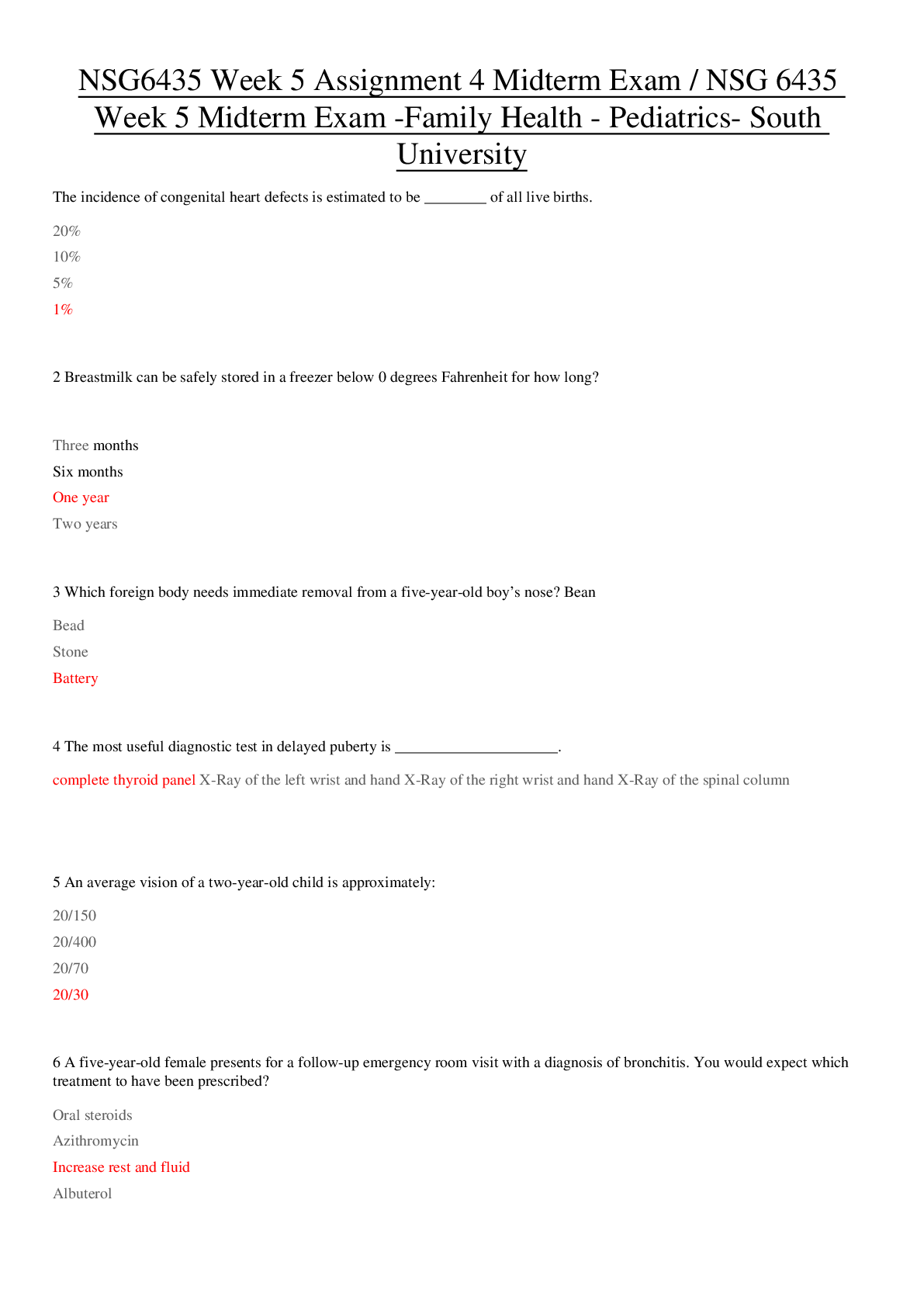
Reviews( 0 )
Document information
Connected school, study & course
About the document
Uploaded On
May 15, 2020
Number of pages
9
Written in
Additional information
This document has been written for:
Uploaded
May 15, 2020
Downloads
0
Views
70

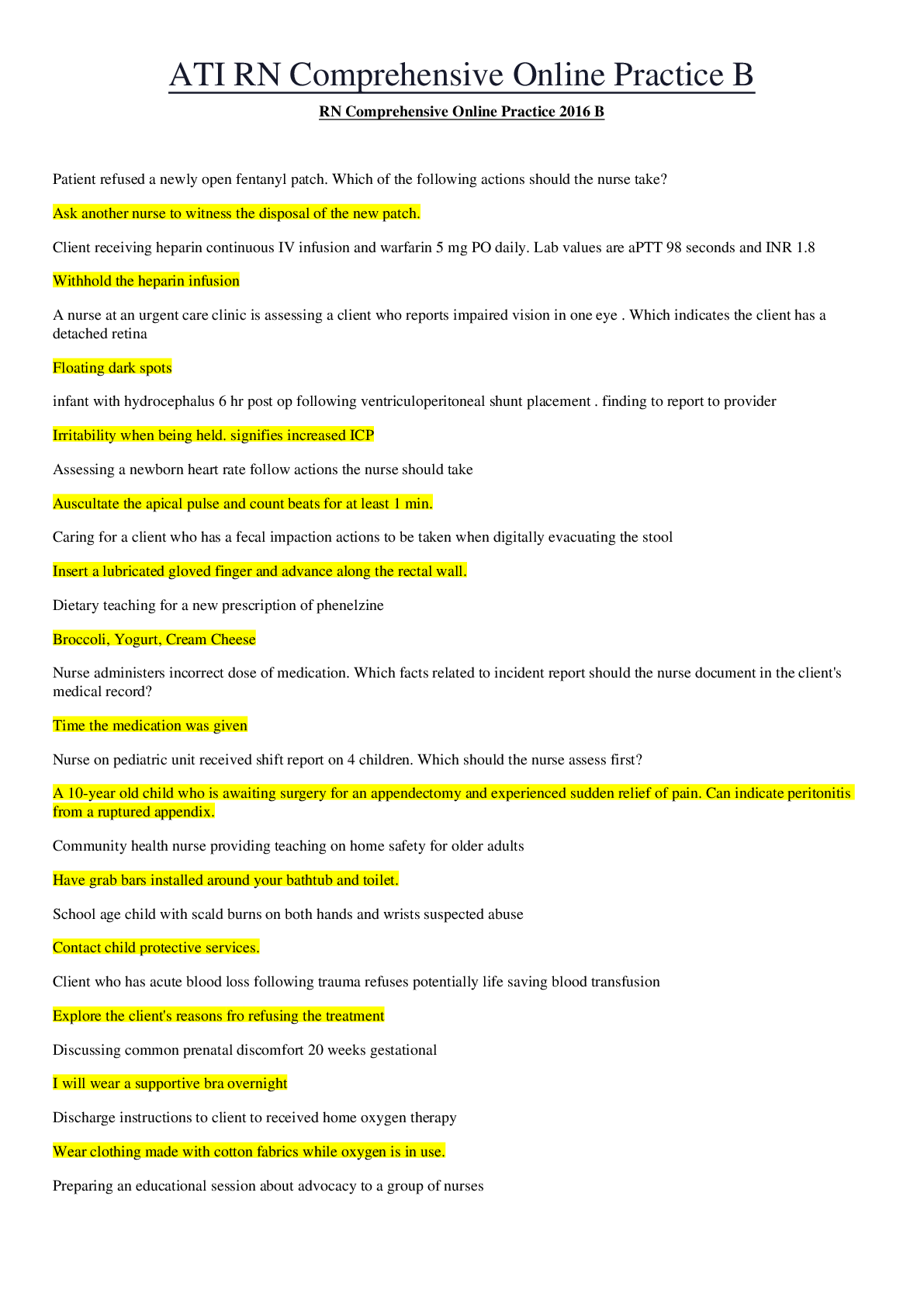
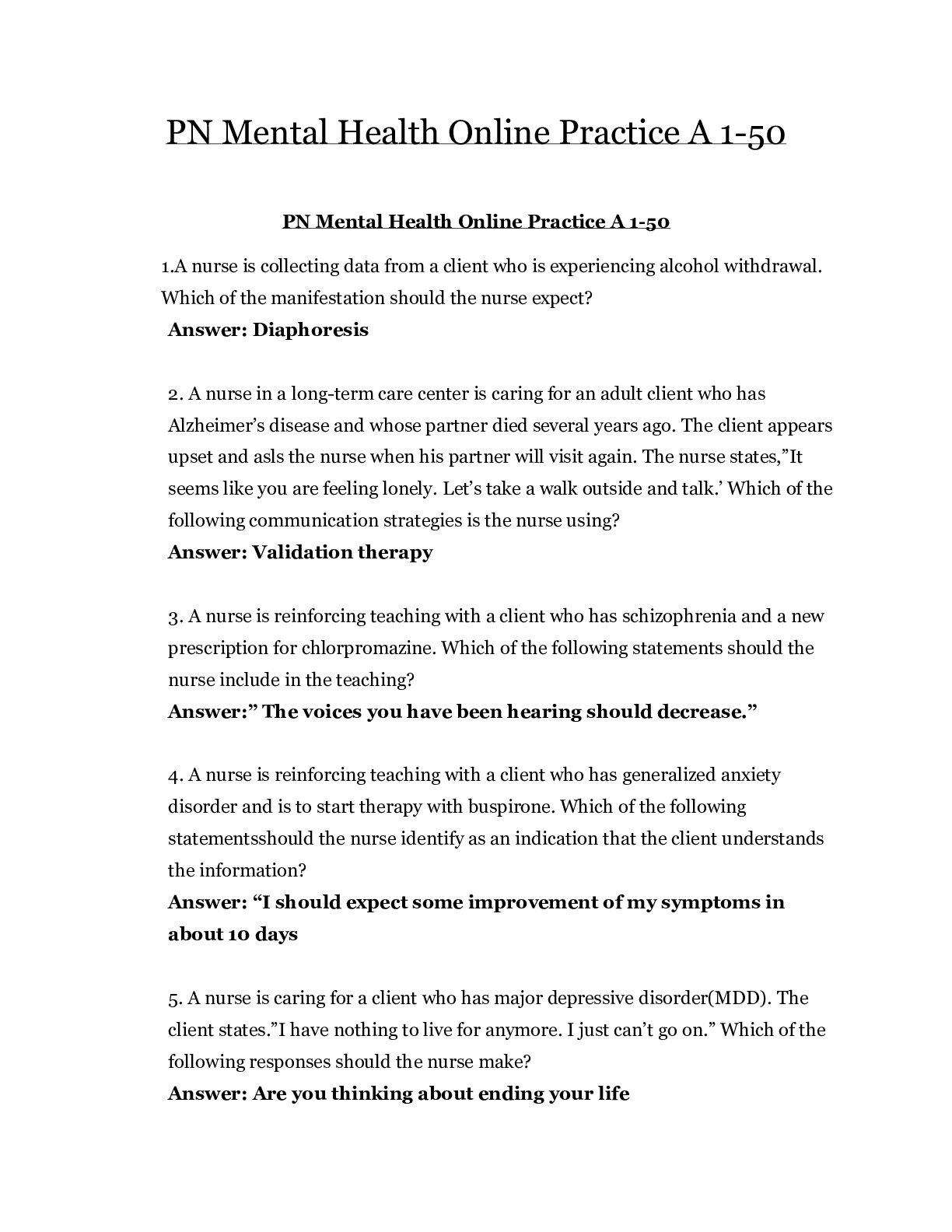
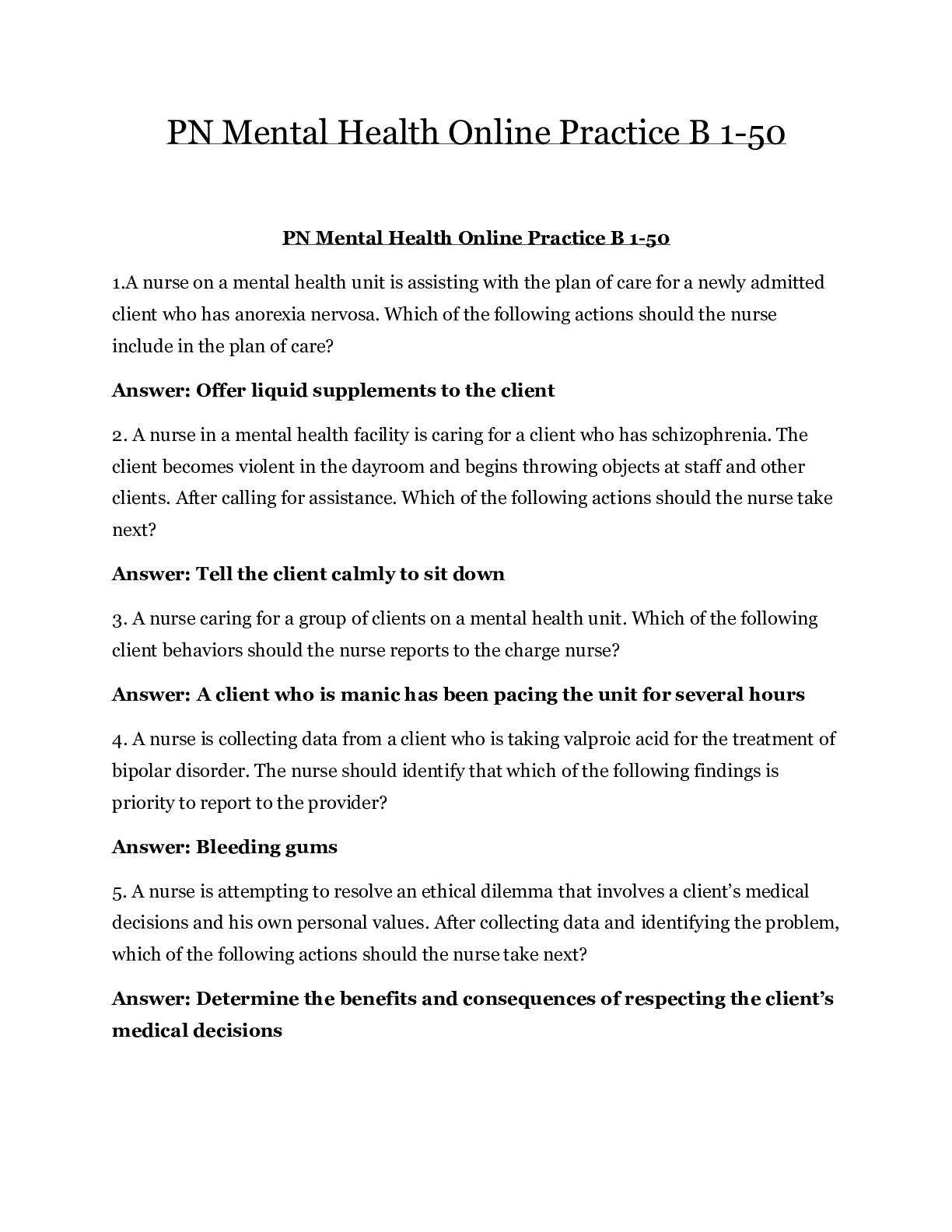
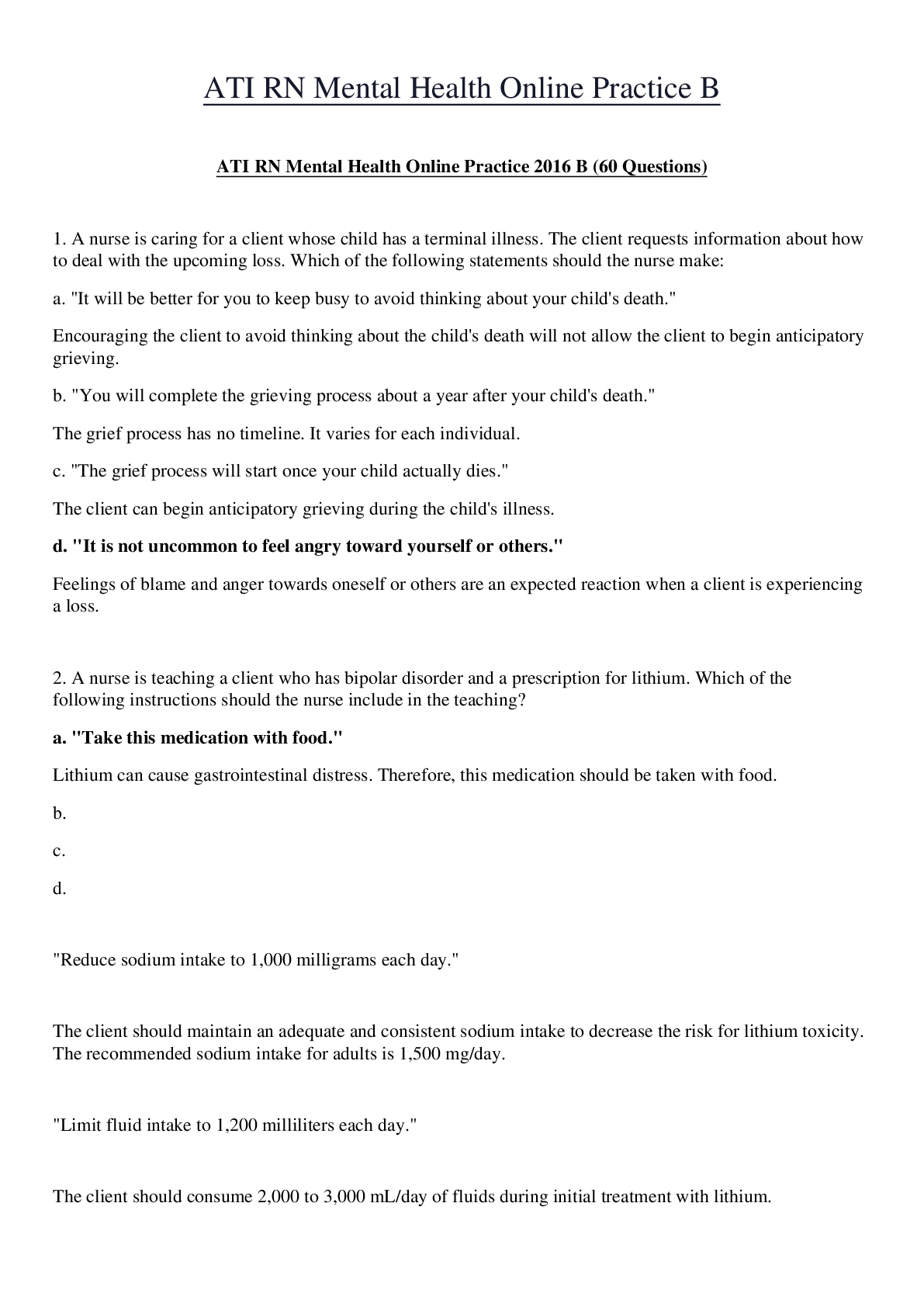


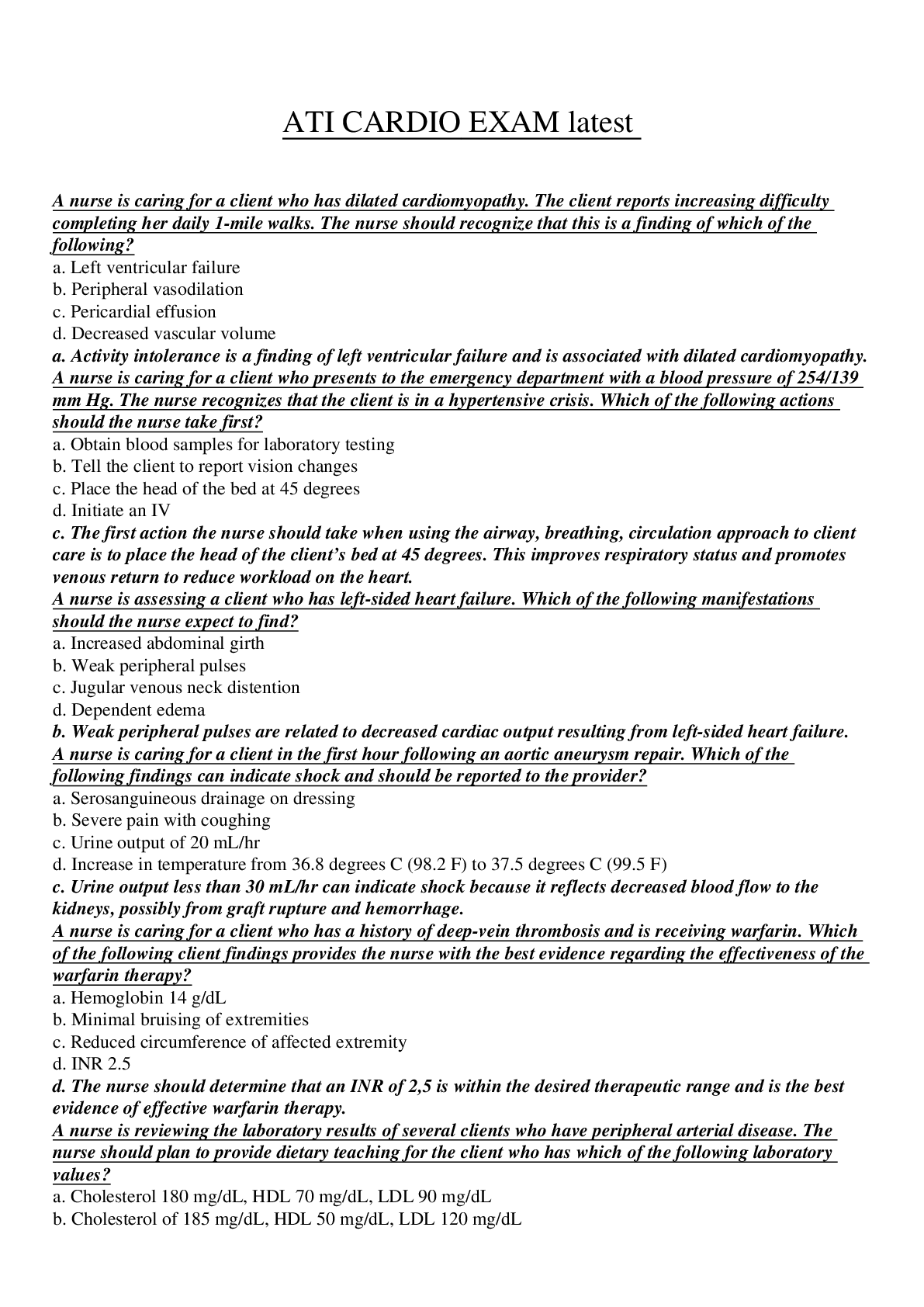
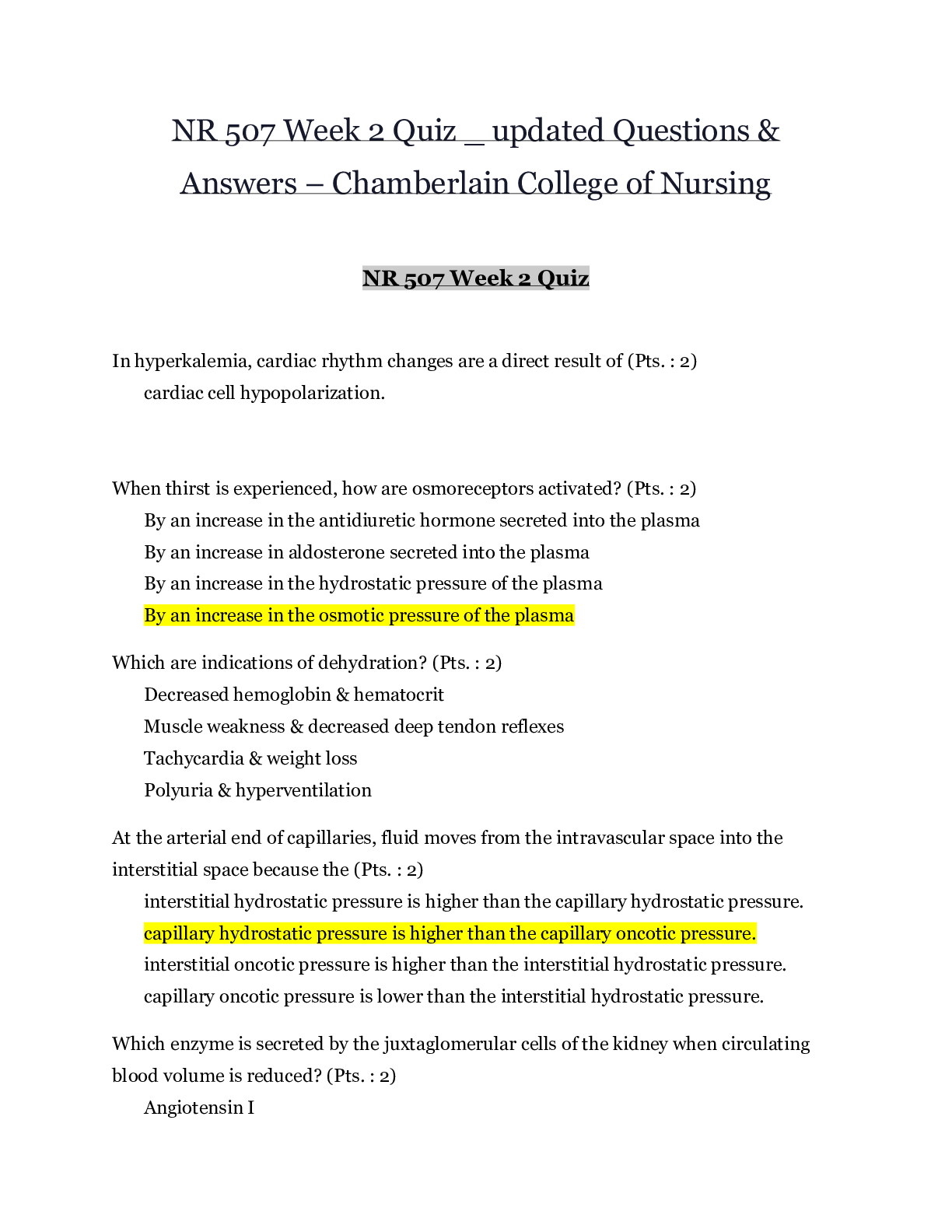
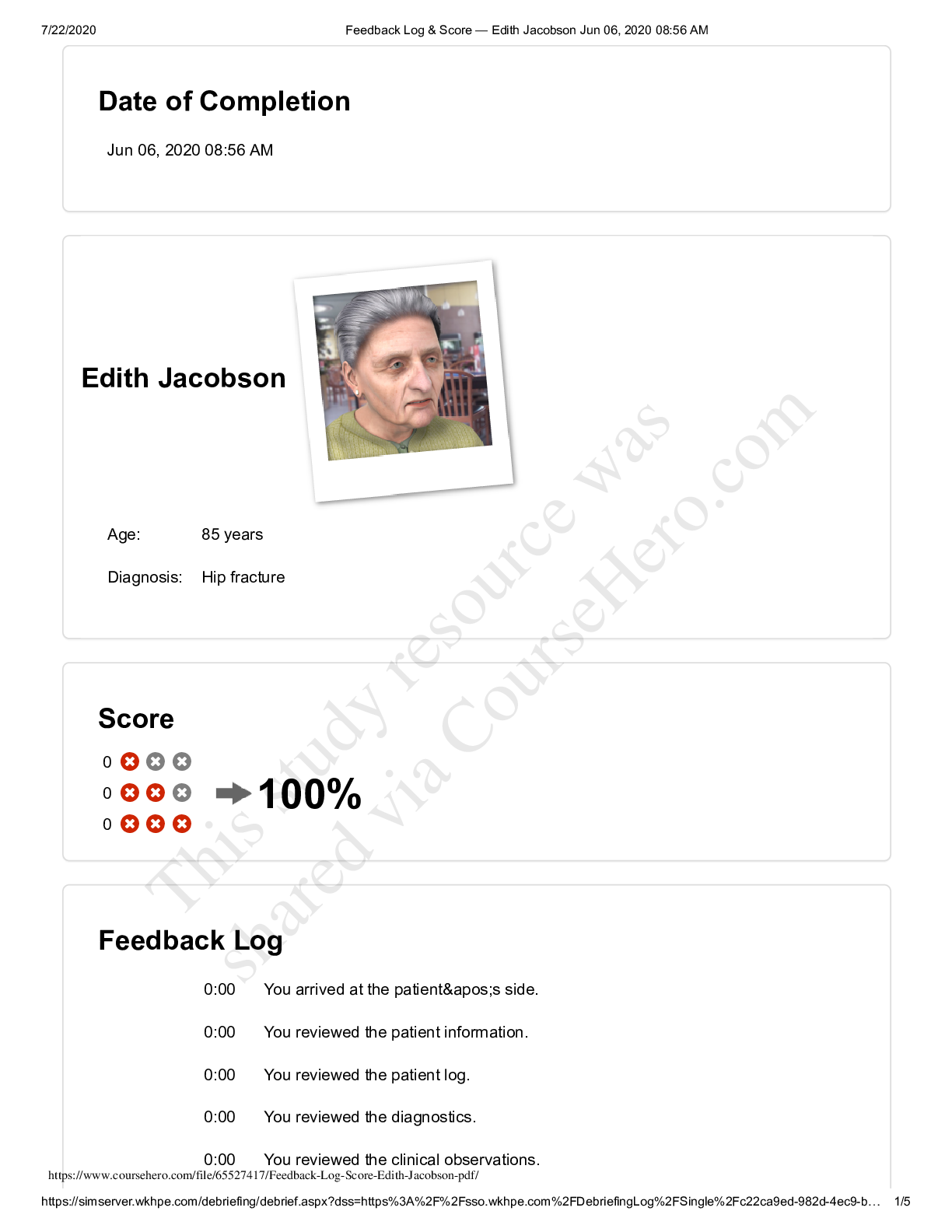
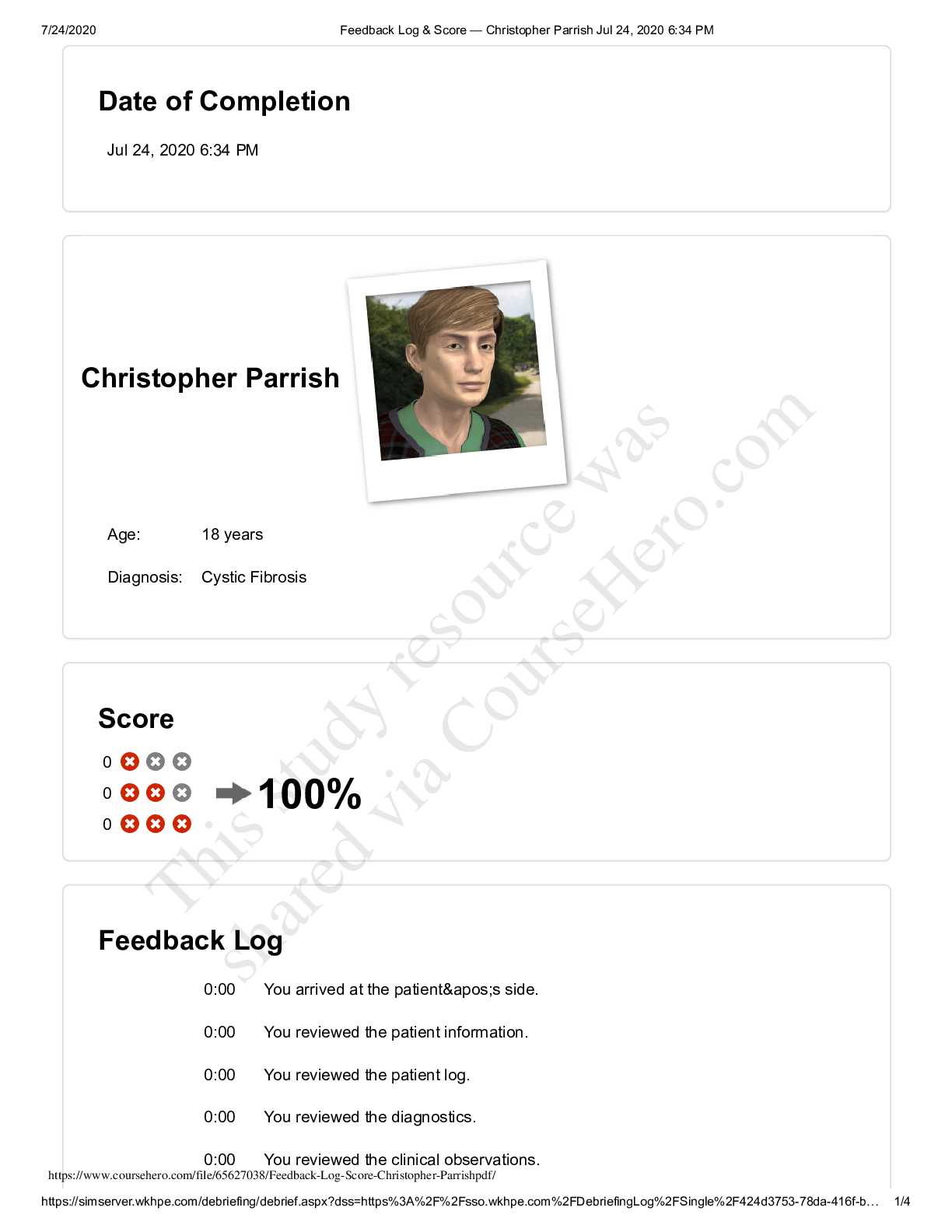
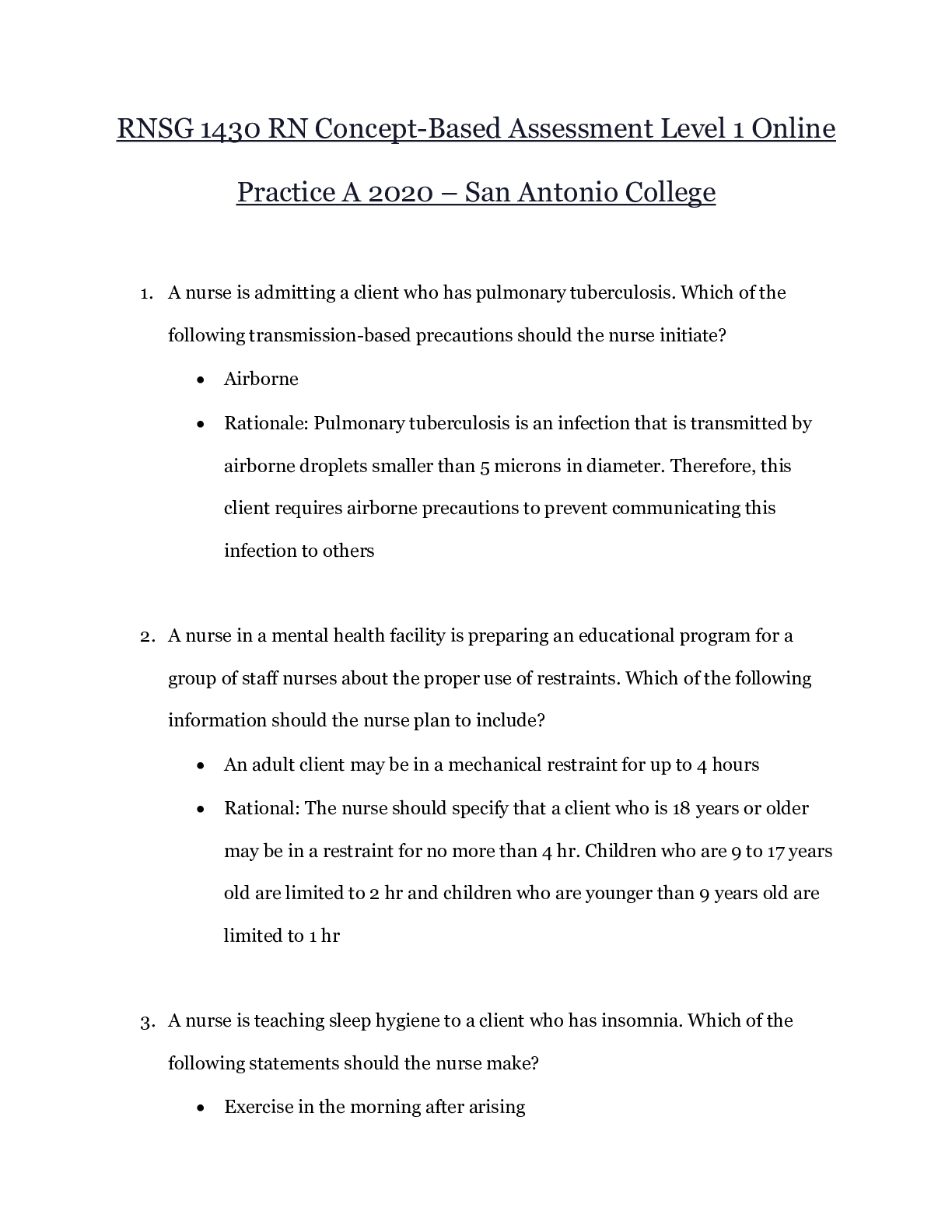


 – CHAMBERLAIN COLLEGE OF NURSING.png)
